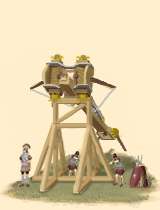Vnvm Talentvm Ballistae (1 Talent Stone Projectors)
 |
Weapons | Defence | Mental | ||||||
|---|---|---|---|---|---|---|---|---|---|
| Primary | Secondary | Armour: | 1 | Morale: | 7 | ||||
| Type: | knife | none | Shield: | 0 | Discipline: | disciplined | |||
| Attack: | 8 | 65 | Skill: | 7 | Training: | highly_trained | |||
| Charge: | 2 | 2 | Recruitment | Other | |||||
| Lethality: | 0.04 | 1 | Soldiers: | 15 | Hit Points: | 1 | |||
| Range: | 0 | 180 | Cost: | 30000 | Mass: | 0.85 | |||
| Ammo: | 0 | 30 | Upkeep: | 4500 | |||||
| Turns: | 1 | ||||||||

The 1 talent stone projectors are the heaviest artillery pieces used by the Roman legions. These powerful weapons can cause havoc to enemy formations and cities as well, but they are seriously limited through their practical immobility.
The 1 talent stone projectors are the heaviest standard artillery pieces used by the Roman legions. The pure view of these intimidating machines, with their height of several meters, usually encourages the own milites nearby, while the loud distinct noises created by the machines vastly increase their terrifying effect on the enemy. The impact of their huge shoots, sometimes bouncing across the earth, can be disastrous for a tight a formation of enemy soldiers. However the towering heavy ballistae are practically immobile, once deployed, slow to reload and nearly impossible to turn, and thus it’s difficult to combat moving targets with them. Consequently they can rarely be of much good in open field battles and are most times limited to sieges. There, a day long bombardment can seriously weaken the defenders and demoralise the besieged people. A city sized target can’t be missed and the powerful stone balls can damage or destroy weakly built walls, towers or parapet walls , drive the defenders from the walls and cause havoc in the quarters behind. Huge and effective incendiary loads can cause fires on multiple places within the besieged city and further increase the chaos and fear created by that wonders of civilized warfare.
All currently used Greco Roman artillery pieces are constructed after the same basic design as two armed torsion powered engines. The torsion springs itself are made of densely packed and drilled animal sinews and human hair, they are used to store the energy until the weapon is fired. The inner ending of the two arms is directly connected to the springs, while the others are attached to a rope that runs to the carriage holding the shoot. When the weapon is loaded the operator push back the carriage, with the help of a winch to master the high forces, so that the springs are twisted. When the piece is released they will move back to their original state and transfer the stored energy to the projectile.
Historically, in the second or third quarter of the first century BC the Roman army introduced a new generation of tormentae , as the Romans called the torsion powered artillery pieces. This first genuine Roman designs, based on centuries of experience with such weapons in the Mediterranean world and some innovations of their own, proved to be a great improvement over the previously used old Greek variants. The engineers had optimized the design of the frame and the two catapult arms so that more energy could be stored in the springs and thus transferred to the projectile, giving it higher range and penetration power.
These new construction was described the first time by the architect and engineer Marcus Vitruvius Pollio, who was part of Gaius Julius Caesar engineer corps overseeing the production of his army’s tormentae and probably participated on their development itself.
In the late 2nd century BC artillery became more regularly used by roman armies to provide the urgently needed barrage fire during siege assaults as well as to defend own fortifications. In the following decades tormentae became a standard equipment of the now more permanent legions, build and maintained by their own engineers. The late fourth century military theorist Vegetius reported that finally every legion had one arrow thrower per centuria and one stone thrower per cohort and thus around 70 pieces available, but this was apparently not the case in the late Republic and early Principate when numbers were somewhat lower. Exact numbers are known for the Jewish war in 67 AD when each of Vespasian’s legions was equipped with ca. 54 tormentae.
Now Roman commanders quickly developed new tactics and made extensive use of their artillery outside traditional siege battles to assault or defend forts and field fortifications, provide fire support for amphibious landings or river crossings, keep enemy archers at distance and even in pitched battles. A development that climaxed in the creation of a truly mobile field artillery with the introduction of carroballistae and other lighter advanced designs into the imperial army around 100 AD.